Hello! Grab a cup of chai or coffee as this blog will take some time to read. It is so worth it as you travel with me to Mahabalipuram, one of the most amazing places I have ever been.
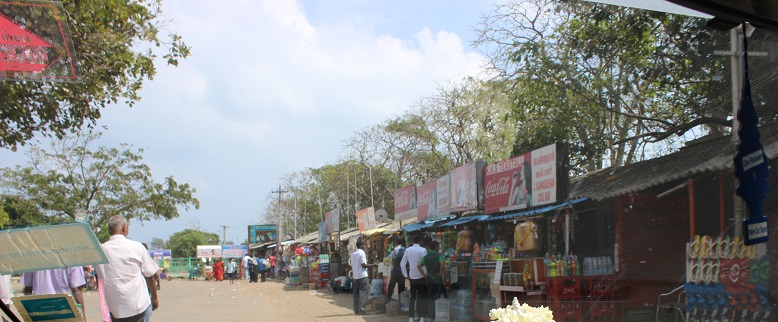
Mahabalipuram, a shining example of the Dravidian culture and of the ancient civilization of the Tamils, is out side of Chennai a little ways. It can be said that the temple architecture, which is a unique feature of the Tamil culture, was born in this place. Soon you will see the magnificent evidence of this! Recognizing the greatness of the monuments of Mahabalipuram and confirming their exceptional Universal value, the ‘Convention Concerning the Protection of the World Cultural and Natural Heritage’ has included them in the UNESCO’s World Heritage list.
But before we arrive, let’s look at the history of Mahabalipuram. Starting from the 6th century AD, the Pallava dynasty ruled over parts of northern Tamil Nadu for about 400 years. Their capital city was Kanchi or Kanchipuram. Mamallapuram was their seaport.
In ancient times even before the Pallavas came on the scene, this place was known by the name Mallai or Kadalmallai. Vaishnava saint Bhoodhaththazhavar was born here. This has also remained a center of pilgrimage and Saint Thirumangal Azhvar has rendered hymms in praise of this place.
Mahabalipuram was a trading center even in the 1st and 2nd century AD, visited among others by the Greeks. Hiuen Tsang, the Chinese traveler of the 7th century mentions that this place was the seaport of the Pallavas. It has also been referred in European literature of the 14th century as the ‘Place of Seven Pagodas’ or the place of seven temples.
The monuments and the temples of Mamallapuram were designed by the Pallava rulers during the 7th and 8th century AD. In the development of architecture and sculpture, the contribution of the Pallava kings is noteworthy. Mention should be made in this regard about Mahendra Varman (AD 580-630), his illustrious son Mamallan Narasimha Varman (AD 630-668), Mahendra Varman II (AD 668-672), Parameswara Varman (AD 672-700) and Narasimha Varman II alias Rajasimha (AD 700-728). Varman literally means ‘he that is protected by’, in this case Lord Vishnu.
The majority of the monuments belong to the times of Narasimha Varman. The name Mamallapuram itself is derived only from the title ‘Mamallan’, ‘The great Wrestler’ of Narasimha Varman. The rest of the monuments belong to the period of his successors Parameswara Varman and Rajasimha Pallavan.
While the credit for designing the temples by scooping them out of living rocks, discarding perishable materials like brick, timber, metal or mortar, goes to King Mahendra Varman, it is the kings Narasimha Varman, Parameswara Varman and Rajasimha who were responsible for Mamallapuram attaining international fame for its sculptural splendor.
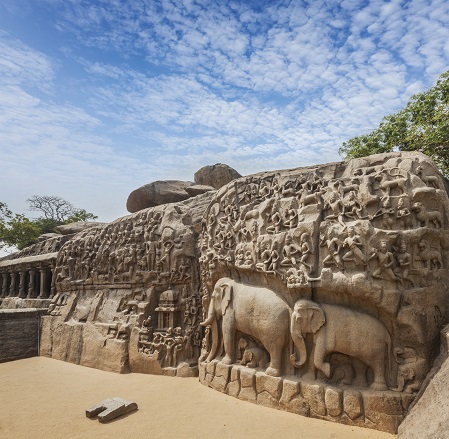
Here we go! We parked the car and as if our eyes could see nothing else, we are drawn to the first monument by the road. This area is called the Hill Area which is a hillock formed by wooded rocks and boulders that lie about one kilometre to the west of the sea.
Descent of the Ganges and Arjuna’s Penance-is a massive piece of art, a real masterpiece in stone, and dates back to the 7th century AD. These types of scultures are known as bas reliefs, and this is perhaps the worlds largest. It is that one is not likely to see anything like the beauty and complexity of this vast relief anywhere in the world. This huge rock measures 25 metres in length and 12 metres in height.
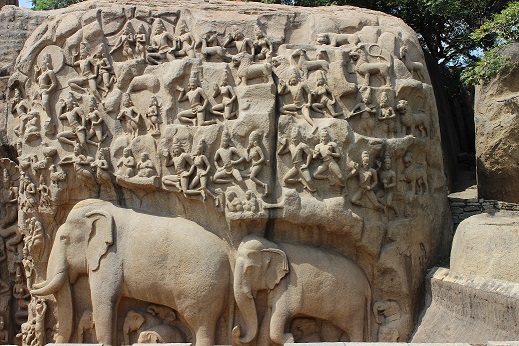
The observer is of course first drawn to the elephants; these are regarded as the finest elephant sculptures in India. The largest elephant clearly exhibits bifurcated tusks (which means that they are split into two pieces, much like a cows hoof), an attribute characteristic of Airavata, the mount of God Indra, the king of the celestial beings. But soon realize that there is much, much more to this piece.
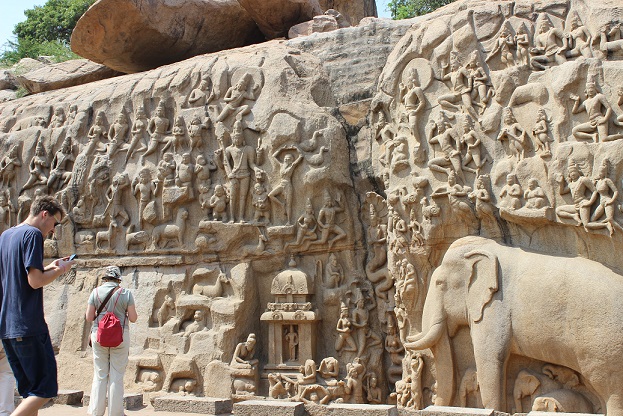
Soon your eyes see a figure that looks like he is doing “tree pose” in yoga and realize this is Arjuna doing penance (sometimes tree pose feels that way!). He is so emaciated that even his rib cage is visible. Arjuna is the hero of the famous epic Mahabharatha.
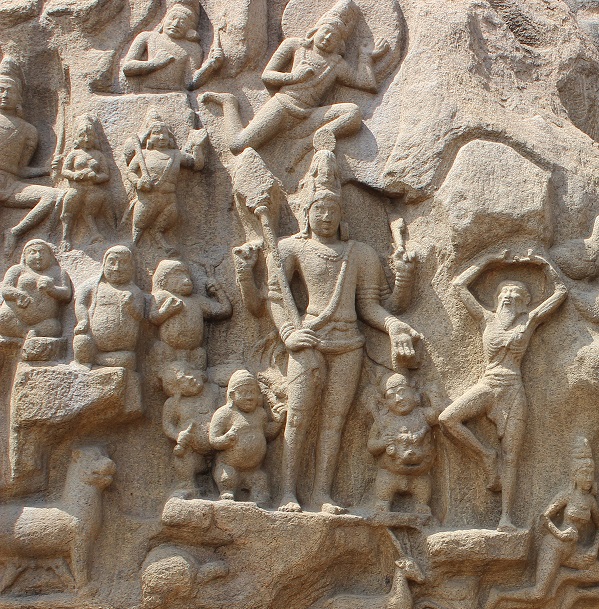
The God figure standing before him is Lord Shiva. Here Arjuna is seen as doing this penance for obtaining the powerful Pasupatha Astra, the weapon from the Lord for the ensuing war with his cousins, the Kauravas. (If you have read the Bhagavad Gita you recognize the story) If you look closely at the figure of Lord Shiva, you can see there is a trident and axe in his hands and a cobra on his chest. His foremost left hand is in the position of granting a boon to his devotee.

And above them, you can see to the left is Chandra the moon, to the right you can see Lord Vishnu and above him even further to the right is Surya the sun!

(These are the two figures that look like they have discs behing their heads).
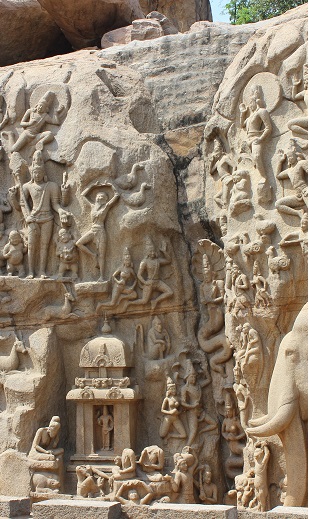
In the middle of the monument, dividing it vertically into 2 halves you can see a narrow fissure which is believed to stand for the holy river Ganga, the Ganges, which originates from the Himalayan range of mountains and runs through the north Indian plains. Scholars believe that this monument represents the descent of the river Ganges from heaven to earth, due to the penance of Bagiratha, who was believed to be instrumental in bringing the river to earth. So we aren’t really sure that this monument wasn’t really about Arjuna, but about Bagiratha. Archaeologist claim that once upon a time, water really flowed in the cleft of the rock. Water is the lifeline of any existence and it can be observed that most of the living beings in the monument are facing the river and many even appear to be rushing towards it.
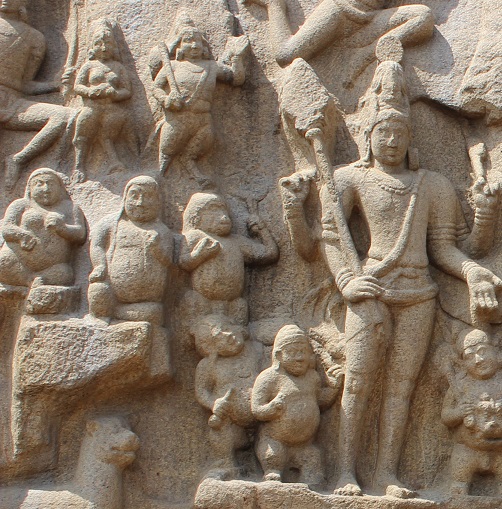
For my Ayurveda readers, can you see the five dwarves that are behind Shiva? They stand for the five material elements, the air, the earth, the space, the fire and the water which are also the correlates of the five senses.
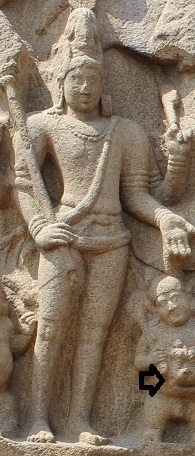
And the belly masked dwarf under the extended hand of Shiva is Pasupatha weapon personified, this representing the boon itself that Shiva grants to Arjuna.
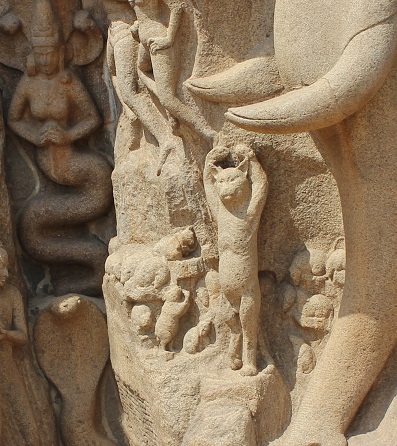
There are also celestial musicians and dancers with heads of men and bodies of birds or horses, lots of animals, and then of course there is the fat cat, also doing penance just like Arjuna, and surrounded by mice! The cat is pretending to be pious and the unsuspecting mice, taking it to be so, shed their fear and start playing around it, while the cat is actually waiting only for the opportune moment to pounce on the mice. In this picture you can see the elephants bifurcated tusks really well.
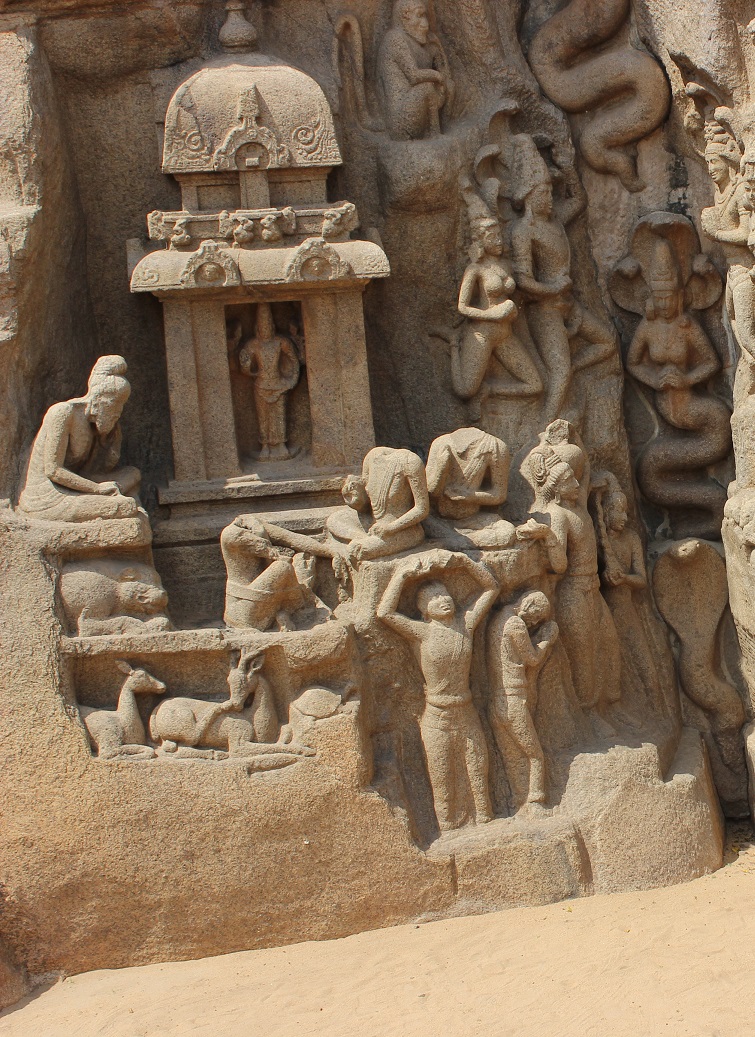
The seated ascetic just outside the temple is Arjuna himself, in his earlier incarnation as Nara, representing the human aspect. Here he is in the company of his friend Narayana or Vishnu, enshrined in the temple, being the divine representation. There are worshipers depicted as standing in ankle deep water, one raising his arms overhead to worship the sun, while the other bowing towards the sacred river. Close by are two bathers performing activities common to any river bank. One wrings out a garment after bathing while the other fetches water in a large jar.
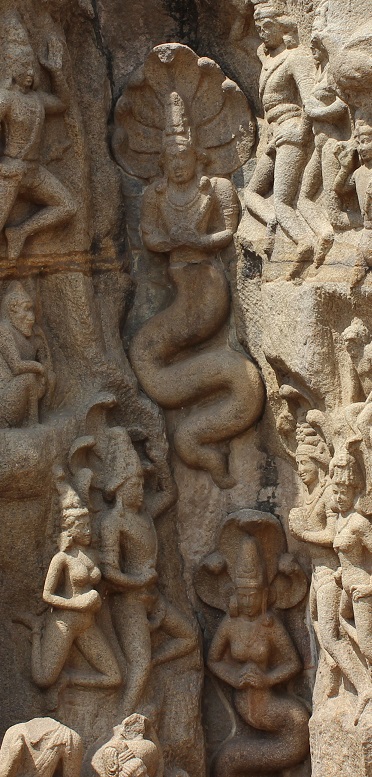
Remember this was the Pallava dynasty. The word Pallava in Sanskrit means ‘sprout’. As per mythology, Ashvatthama, son of Drona and a character in the epic Mahabharatha, fathered a son through his liaison with a snake princess. The child was named Pallava after the lotus ‘sprouts’ upon which he was laid at birth. As per mythology, the dynasty this Pallava originated became the Pallava dynasty.
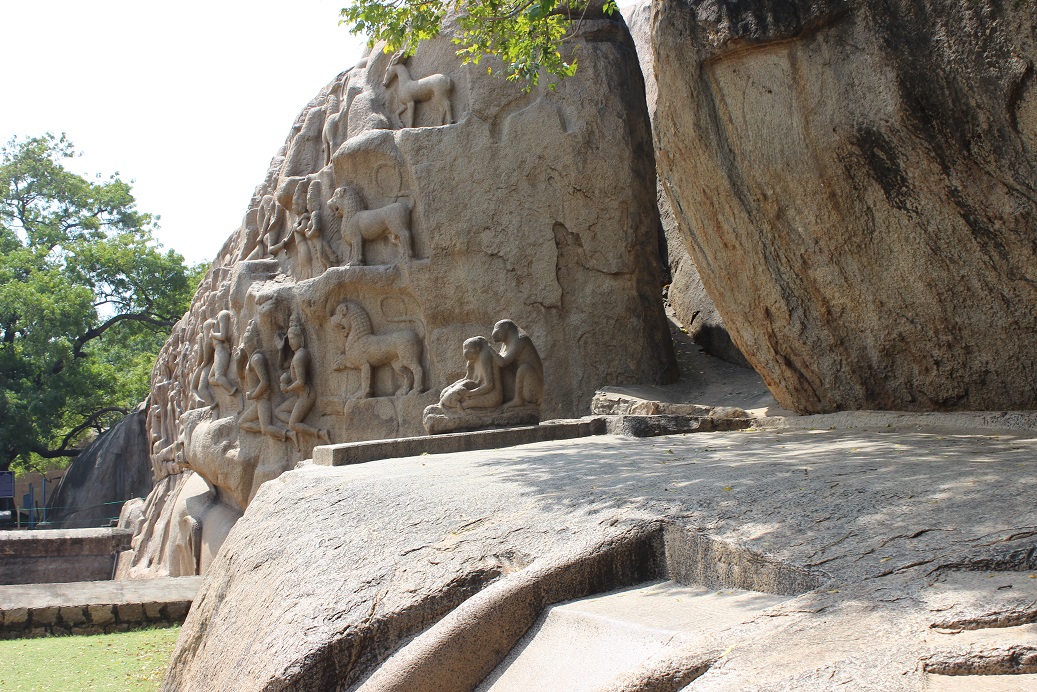
Off to the side of this grand rock you find the sculpture commonly known as the Monkey Checking for Lice.
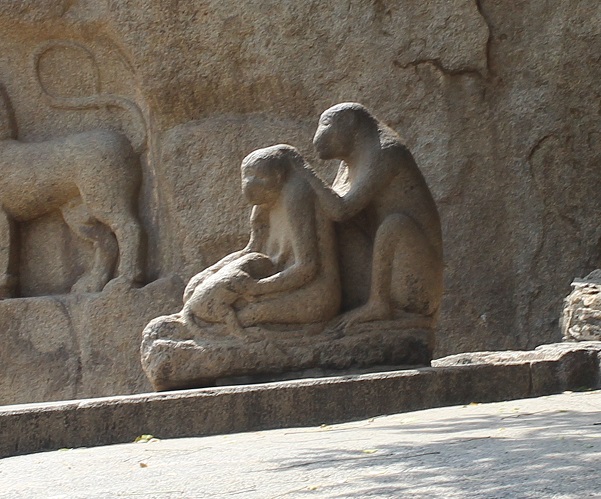
Monkey love has been spoken highly of even in the ancient literature. Love and affection are not an exclusive privilege of only the human beings. Love is very common even among monkeys. Here the little family, dad, mom and baby spend a moment together as the male monkey hunts for lice and the baby monkey nurses.
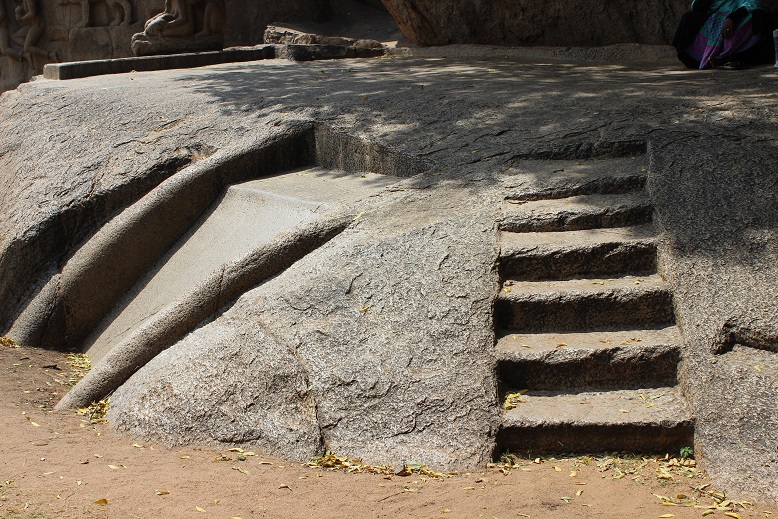
Maybe the world’s first children’s playground, this set of stairs and slide must have kept the children of these rock carvers entertained while their parents worked.
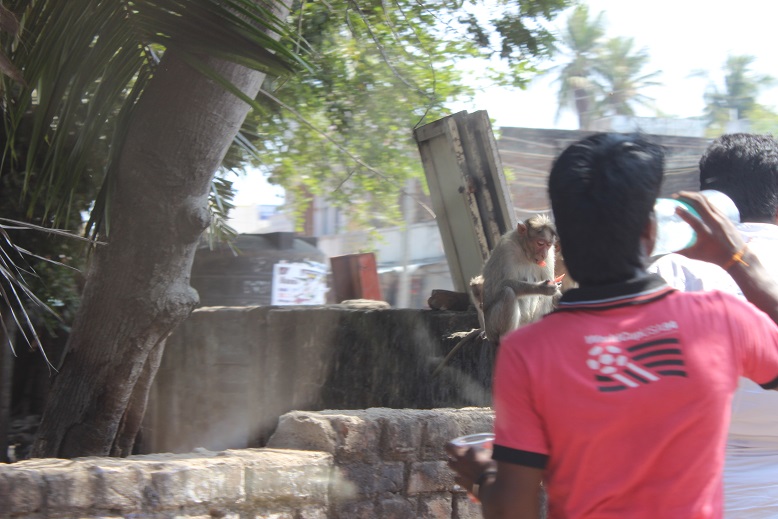
Speaking of monkeys, they have learned that the tourists will feed them!
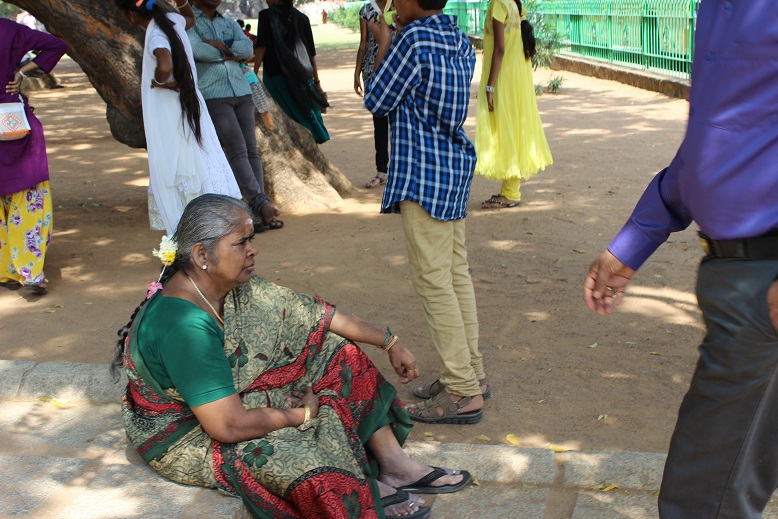
Between the temples, people were just relaxing and taking it all in.
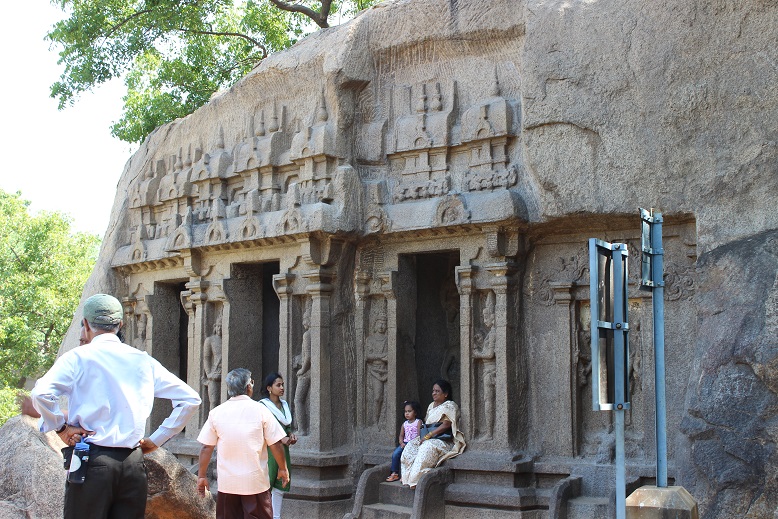
Trimurthy Cave is the next monument we visited, also known as the cave temple. The cave temple is dedicated to the Hindu Trinity, Brahma-the Creator, Vishnu-the Preserver and Shiva-the Destroyer, the three important Gods of the Hindu pantheon.
There are separate cells, i.e., sanctums for the three Gods. Outside each cell, there are beautiful pillars and formations like decorated towers. The entrance of each cell is flanked by guards, known as Dvarapalas. In each cell there are devotees kneeling on the floor and praying to the God, while there are dwarf ganas above in flying positions.
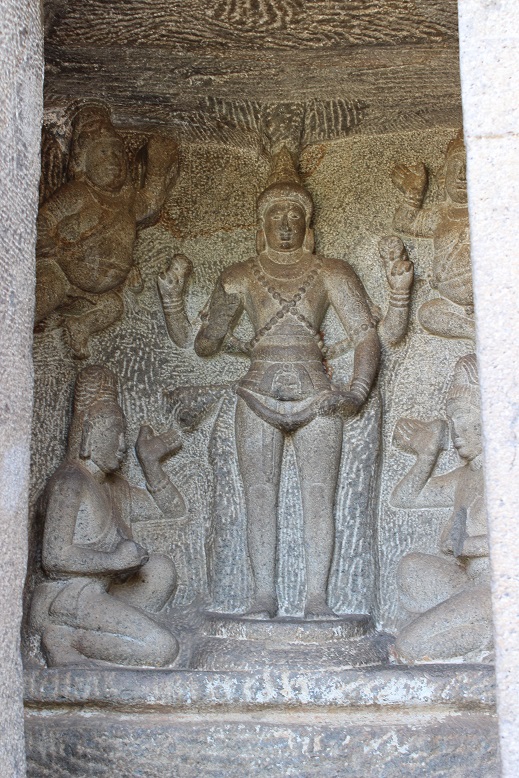
In the first cell is Lord Brahma. It is rare to have a temple for Brahma. There are only very few temples in India devoted to this God. Normally Brahma has four faces and he is generally known as the Four Faced God. But here unusually he has got only a single face and wears a cross garland of rudraksha beads. He carries a rosary and water vessel in his upper pair of arms, while the position of the other two arms are in abhaya and katyavalambita mudras, as in the case of the other two deities.
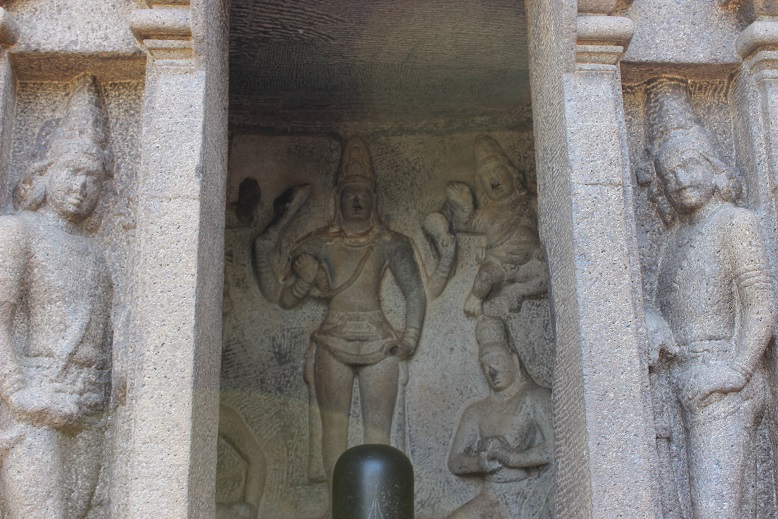
The middle cell is for Lord Shiva. One can see the shining shiv-ling in front. In temples, one normally does not get to see the image of Shiva. There will be only the Shivling. But here stands the four armed Shila in full form. He is carrying an axe and rosary in his upper pair of arms. The guards and the flying ganas can also be seen.
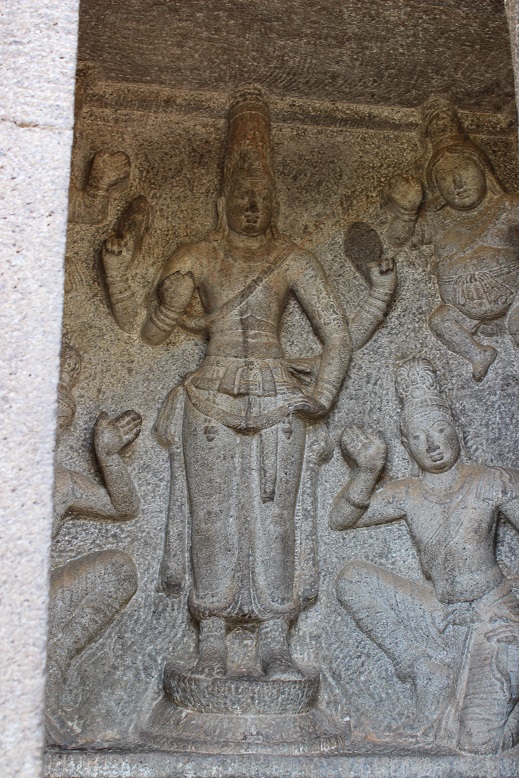
The last cell is for Lord Vishnu. He holds a conch and discus in his arms.
A short word on the Mudras. Abhaya Mudra is the pose of the hand in which the lord holds his hand aloft, with the right palm facing the devotee with all the fingers of the hand pointing upwards. The Katyavalambita Mudra pose if the one in which the lord keeps his (left) hand on the waist. There is one more common pose known as the Varada Mudra. This is the pose in which the lord holds his (left) hand with the palm facing the devotee with all the fingers of the hand pointing downwards.
Before moving to the next temple, something caught my eye.
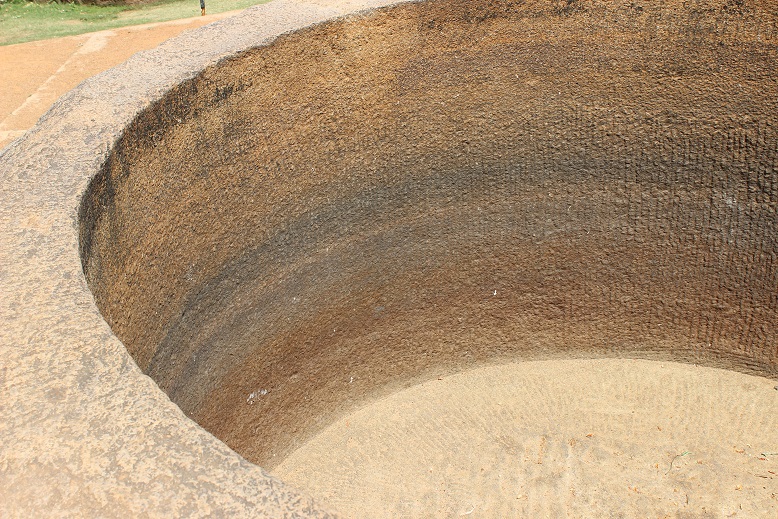
A big rock with a carved out hole, supposedly used to hold drinking water!
Near the Trimurthy Caves is one of the craziest things I have ever seen, Krishna’s Butterball!
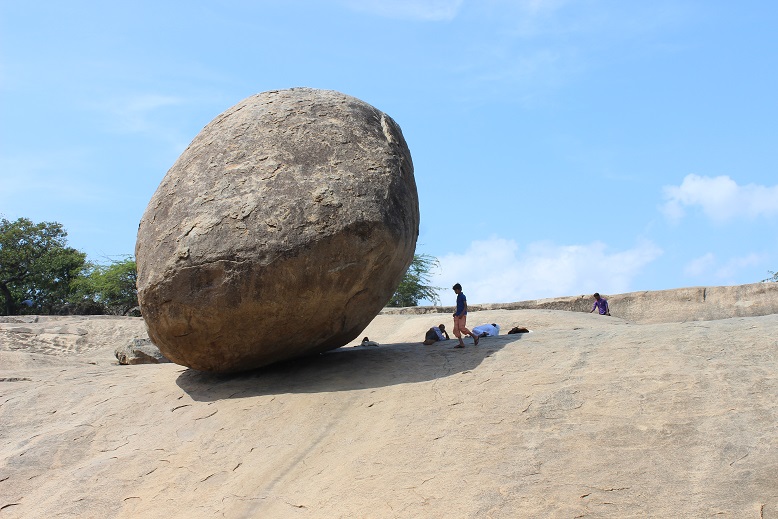
It looks like a big boulder has been placed on a huge rock. This will not roll down. This has not moved for centuries, not even during the tsunami. Called Krishna’s butterball after the prodigious fondness for butter that Krishna had as a child.
Actually this is not a boulder placed so very precariously on a rock. In reality, the flat rock at the bottom and the irregular sphere shaped boulder on top are just two different portions of the same rock. This is a monument designed by nature itself. It is said that for many, many thousands of years, it must have remained exposed to the forces of nature, heated by the sun, drenched by the rain and corroded by the wind. Slowly but surely the rock must have shed its skin. Fissures might have been formed, which must have widened, with flakes of rock washed away by rain, resulting in rounded forms. Ultimately it must have got the shape of a boulder standing on top of a rock!
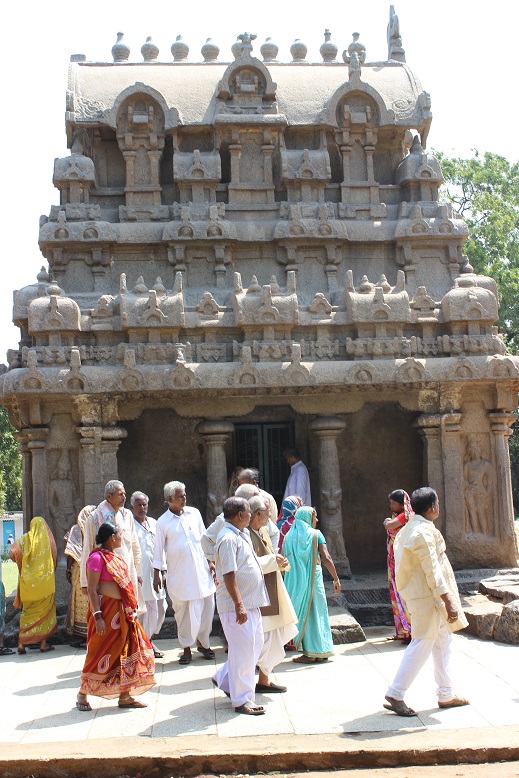
Next came the Ganesa Ratha, a beautiful monolithic temple. This structure, carved out of a single rock, during the reign of Parameswara Varman in the latter half of the 7th century AD, resembles a chariot and hence has got the name Ratha. There is a cell beyond the front hall, which once upon a time must have housed a Shiv Ling or lingam. (a representation of the Hindu deity Shiva used for worship in temples. In traditional Indian society, the linga is rather seen as a symbol of the energy and potential of God, Shiva himself.)
Now it has a big figure of Lord Ganesa.
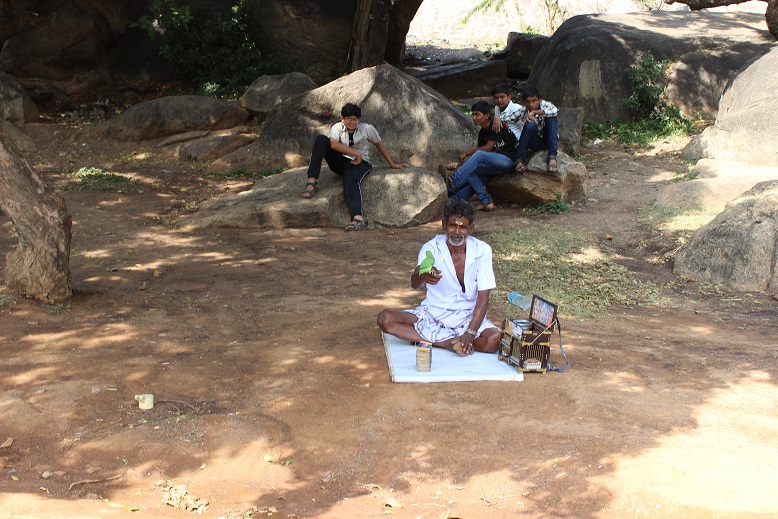
As we are walking to our next area I spot this cool dude sitting on the ground with this beautiful yellow bird. Darshan noticed me taking a picture and he said “You know that is a jyotish”. Surprised but not surprised, I said, well let’s move on then, I think I have had enough fortune for one trip! We laughed!
The Five Rathas are monoliths, which are freestanding temples cut out of solid rock.
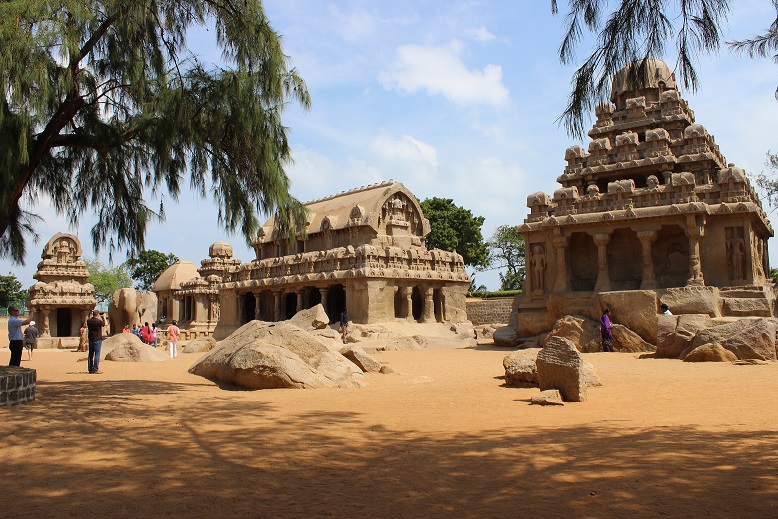
The word Ratha means chariot, and these five temple monuments lined up look like vehicles in a parking lot. These five monoliths here are known as the Pancha Paandava Rathas, after the Paandava brothers, the heroes of the epic Mahabharatha and their common queen. These monolithic temples have been carved out of a hillock, a huge single rock.
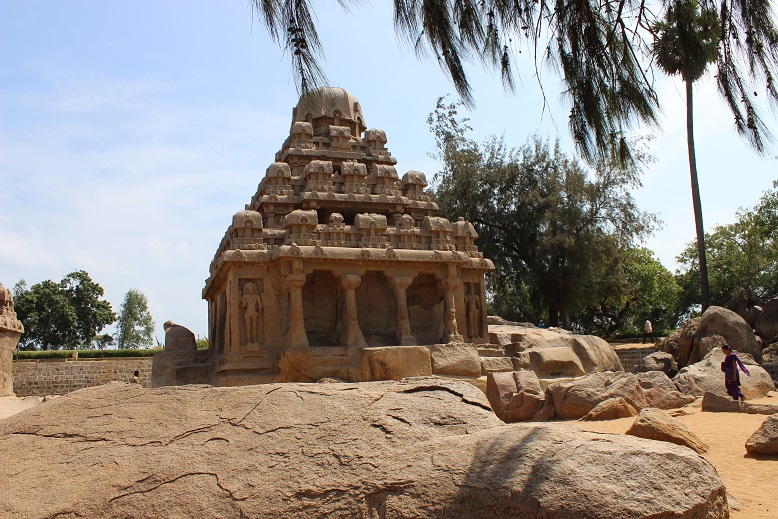
The Arjuna Ratha has carved panels on all sides, with figures of guards, ascetics, and royal couples. Shiva is leaning on Nandi (his bull), Indra on elephant Airavatha and Vishnu leaning on Garuda (his eagle).
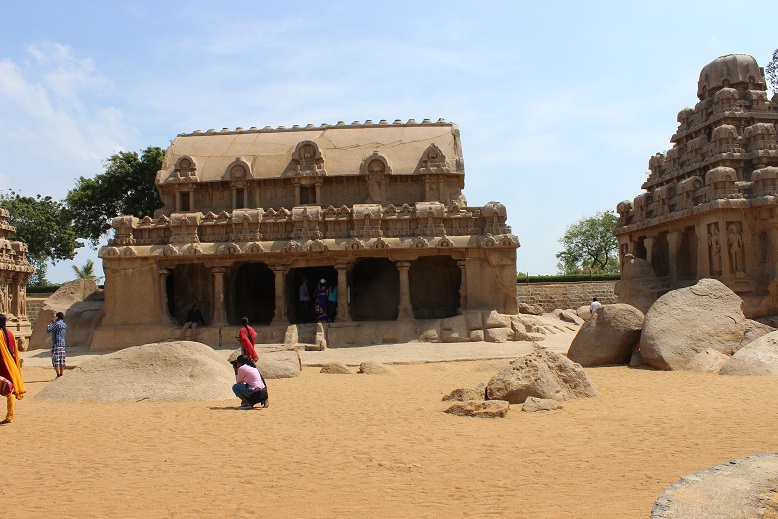
The Bhima Ratha is elongated on a rectangular base and is supported by four lion pillars and too pilasters. It replicates a Buddhist chaitya, that is temple. It does not contain any figure carvings.
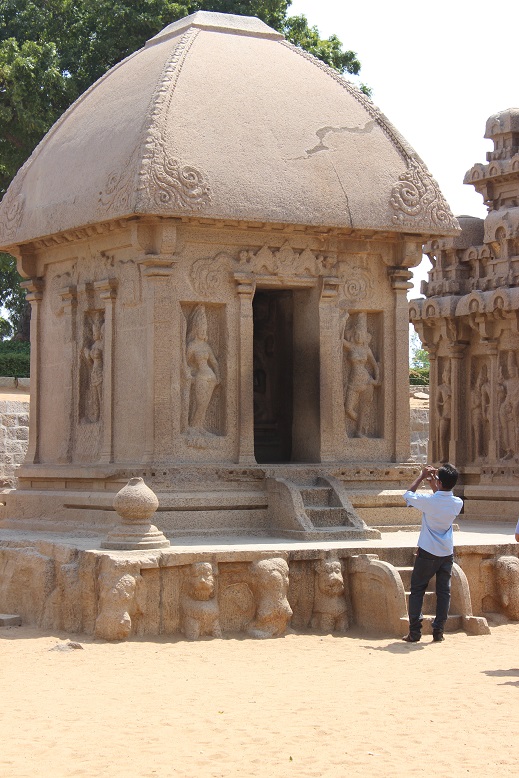
The Draupathi Ratha is dedicated to Goddess Durga. It is in the form of a simple South Indian hut. There are makara (alligator/crocodile) torana decorations all around outside with images of Durga. In the cell inside, there is the four armed standing Durga, adored by two male devotees kneeling at her feet and four dwarf ganas flying overhead. Two dvaraplaikas, female guards, flank either side of the entrance. In front is the majestic lion vehicle of Durga. The elephant and lion carvings are supporting the monument, as you see with many monuments in India.
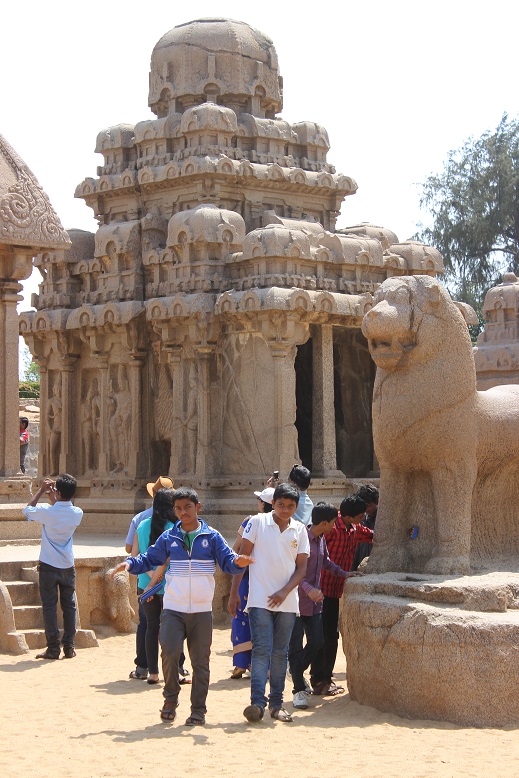
The Dharmaraja Ratha features Ardhanaareeswara, a combination of Shiva and Parvathi in a single figure. The half male and half female is beautifully done as the male side looks masculine and the female side has graceful anatomical details.
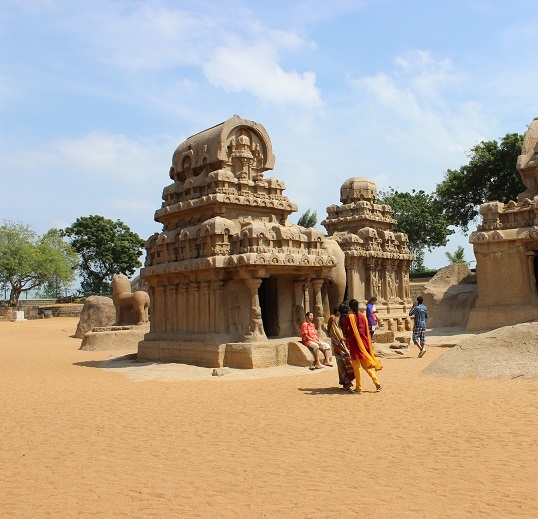
The Nakula Sahadeva Ratha is an apsidal one with ornamental features. There are no figure carvings in this temple. The porch is supported by two lion pillars.
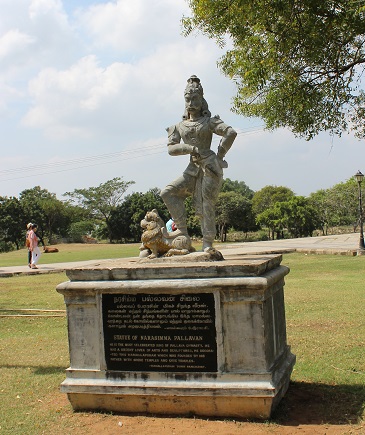
The Statue of Narasimma Pallavan-He was the most celebrated king of Pallava dynasty. He was an ardent lover of the arts and sculptures. He decorated this Mamallapuram which was founded by his father with shore temples and cave temples.
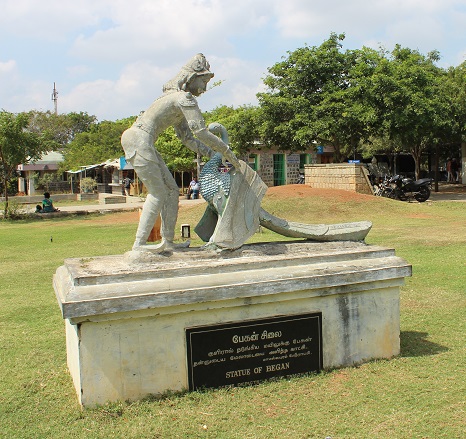
Statue of Began-This was one of my favorite stories. This depicts a great king whose responsibility was to make sure the weather was always warm. This peacock (the bird of India) did not go to warmer climate not anticipating a cold spell. The king feeling responsible for the pain and suffering of this peacock apologized to it for not paying attention to the weather conditions and offered the bird his cloak so as to stay warm.
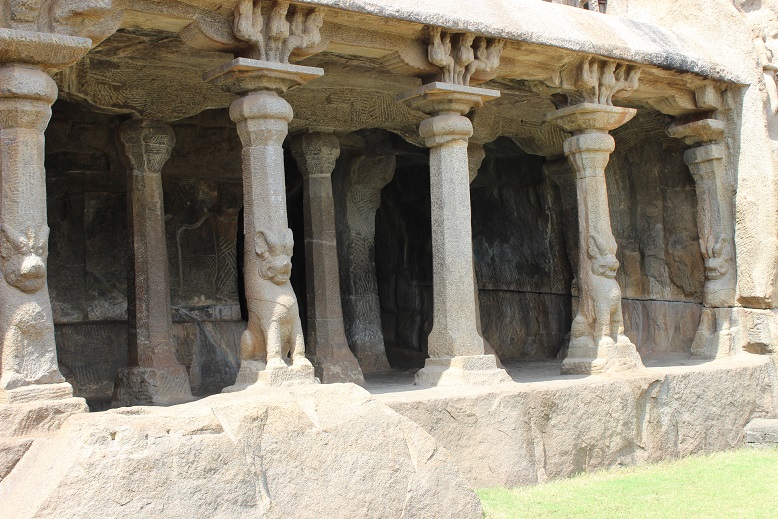
Pancha Paandava Cave-this is a cave carved into a rock. The cell at the back of the cave can be termed as the sanctum of this cave temple. It is just empty, without any image or idol but has impressive decorative lion pillars on the outside.
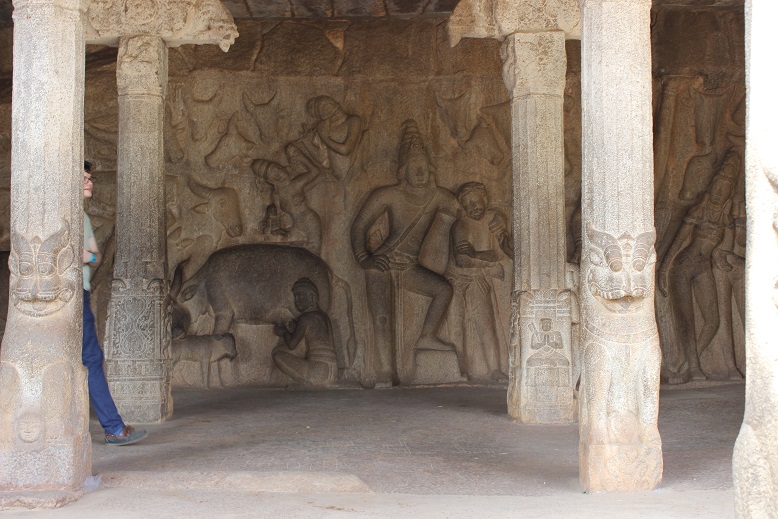
Krishna Mandapam is a pillared hall in which one finds a depiction of a story from Indian mythology. There was a young boy in the village by the name of Krishna. This Krishna is regarded as an incarnation of lord Vishnu himself.

In order to save the people of the village, he lifted the mountain called Govardhana Giri and held it aloft like an umbrella. People and the animals took shelter under the mountain and the village was saved from destruction.
The Shore Temple is the one that comes to mind when one mentions the name Mahabalipuram. It was constructed by Rajasimha also known as Narasimha Varman II, in the 8th century, and is thought to be the forerunner to the great temple architecture of Tamilnadu.
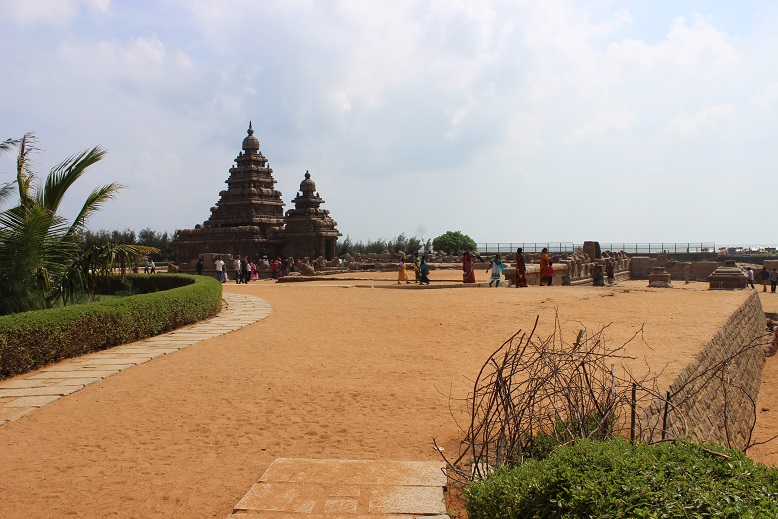
This temple has been standing here majestically, in the sand right on the sea shore, for more than a thousand years.
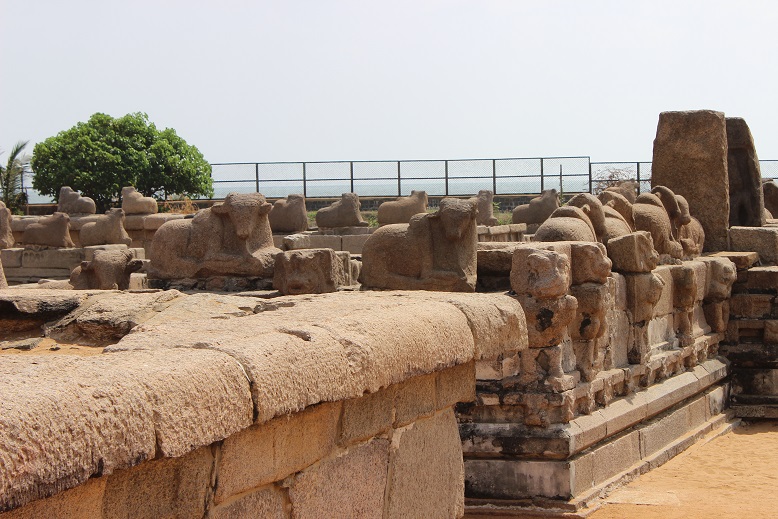
There are three temples here. The one facing east and also the sea is the main temple. It is called Kshatriyasimha Pallavesvara shrine. You have to climb up some steep steps to get in to the temple. There is a porch in front, beyond which is the main cell.
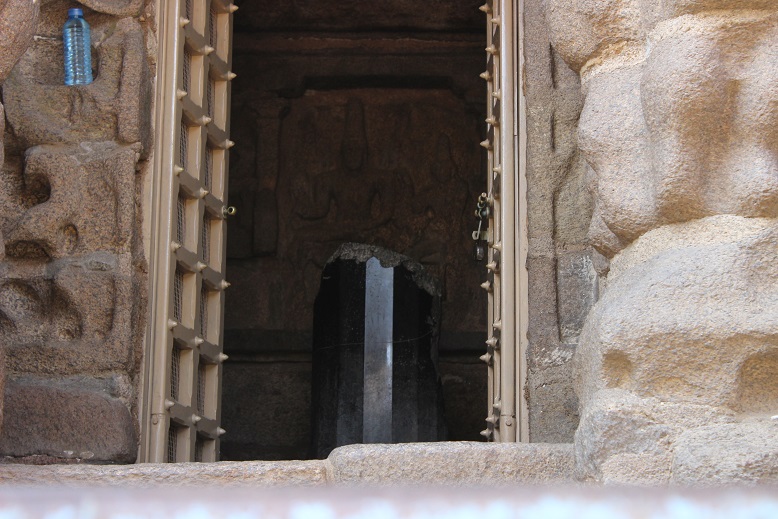
You see the Shiva Lingam in the sanctum. Known as Dhara Lingam, this fluted Shiva Lingam is broken, but still bright and smooth as it is made of granite. There are sculptures behind it and also on either side on the walls of the porch that are barely visible in this photo.
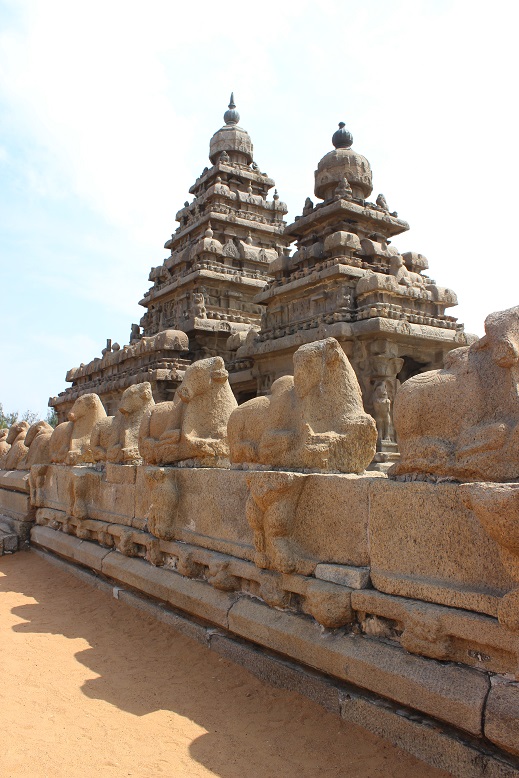
Surrounded by lions, many of them are actually obliterated after the years by the action of the sea. In the small cell, one has to peep in to see the figure of Vishnu. He is known as Palligondaruliya Deva, “the God who was pleased to go to sleep” and the temple is called Narapathi Simha Pallava Vishnu shrine. The Lord is just lying on the ground. Having given up everything including the serpent couch, the conch and the discus, he seems to be at great peace with himself.
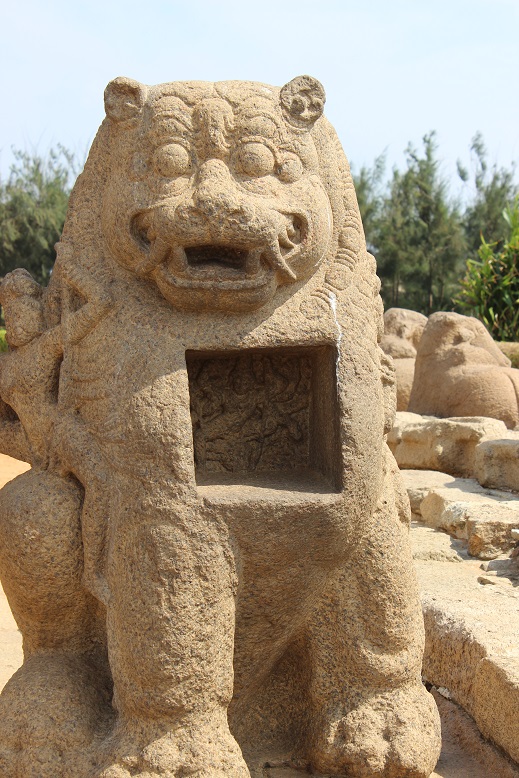
This lion was awesome.

It is Durga’s lion, and if you look to the side you can see her as if she is trying to jump over and start riding on the lion’s back.
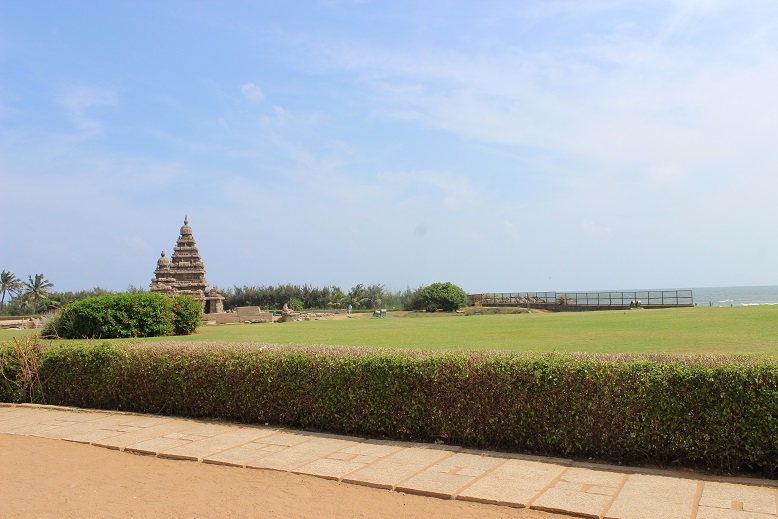
As we walk back to the van, I turned and took one more look.
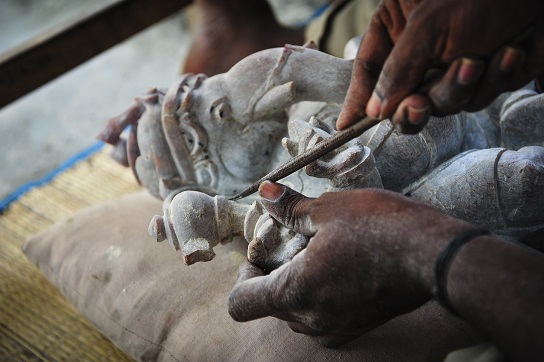
As we get closer to the van, we also see students and teachers carving the stone, keeping the tradition alive.
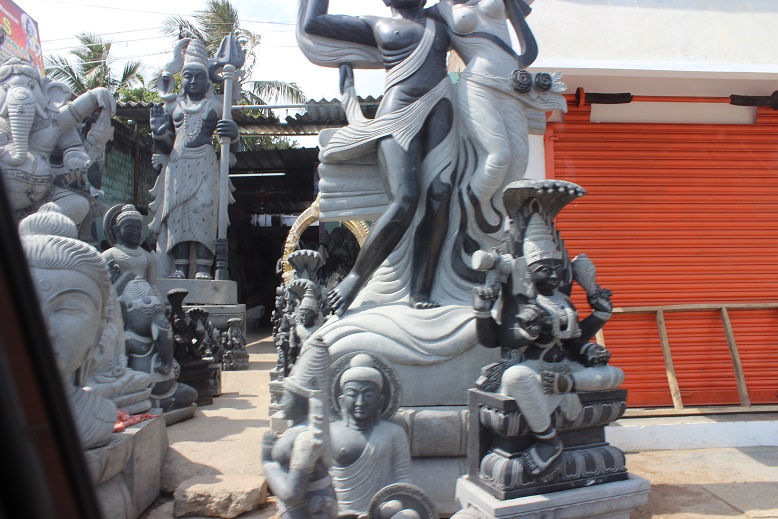
As we were driving out of the area, we passed many stone carving schools.
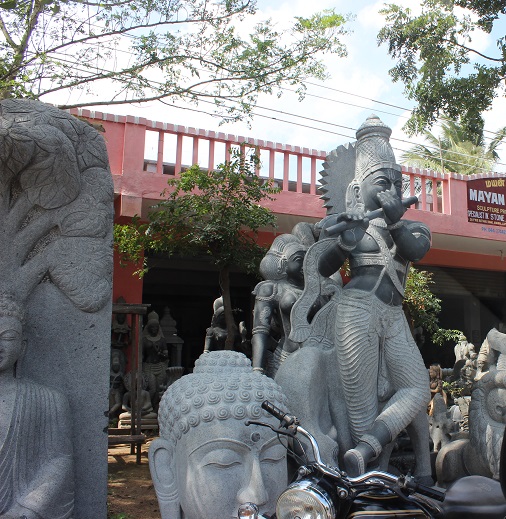
It has been an exhausting but magnificent afternoon. Catch my next blog for the ride back to Chennai. I am going to the Himalayan Institute for a few days, so I will continue recapping my journeys when I get back.
Thanks for reading and sharing. I referenced, Mahabalipuram, a journey through a magical land, by Srinivassa-J. Prabhakar
Blessings always,
Peggy
